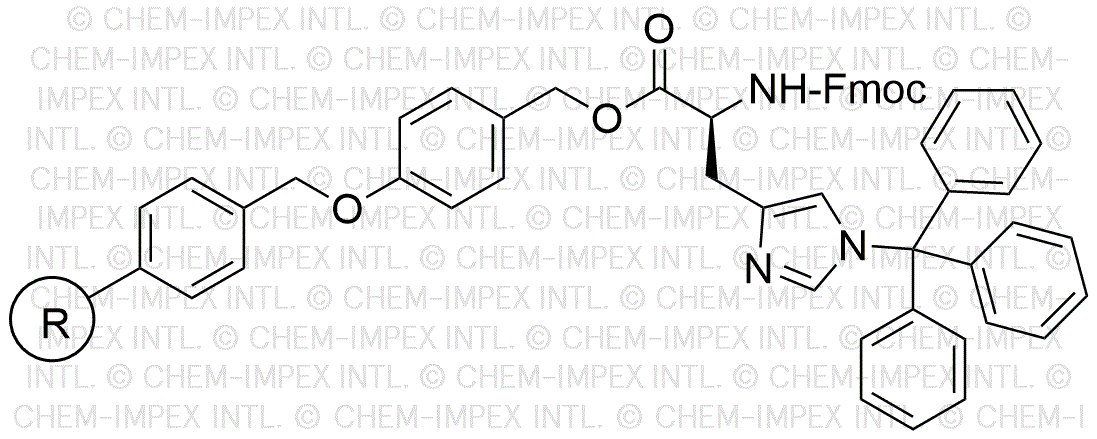Na-Fmoc-Nim-trityl-L-histidine 4-alkoxybenzyl alcohol is widely utilized in research focused on:
- Peptide Synthesis: This compound serves as a protecting group in the synthesis of peptides, allowing for selective reactions without interfering with other functional groups. This is crucial in developing complex peptides for pharmaceuticals.
- Drug Development: Its application in drug formulation helps in enhancing the stability and solubility of active pharmaceutical ingredients, making it valuable in the pharmaceutical industry for creating effective medications.
- Bioconjugation: The compound is used in bioconjugation processes, where it facilitates the attachment of drugs to antibodies or other biomolecules, improving targeted delivery systems in cancer therapy.
- Research in Biochemistry: It plays a significant role in biochemistry research, particularly in studying protein interactions and functions, which is essential for understanding various biological processes.
- Material Science: The compound can be utilized in the development of smart materials, where its unique properties contribute to creating responsive systems for sensors and drug delivery applications.
Información general
Propiedades
Seguridad y normativas
Aplicaciones
Na-Fmoc-Nim-trityl-L-histidine 4-alkoxybenzyl alcohol is widely utilized in research focused on:
- Peptide Synthesis: This compound serves as a protecting group in the synthesis of peptides, allowing for selective reactions without interfering with other functional groups. This is crucial in developing complex peptides for pharmaceuticals.
- Drug Development: Its application in drug formulation helps in enhancing the stability and solubility of active pharmaceutical ingredients, making it valuable in the pharmaceutical industry for creating effective medications.
- Bioconjugation: The compound is used in bioconjugation processes, where it facilitates the attachment of drugs to antibodies or other biomolecules, improving targeted delivery systems in cancer therapy.
- Research in Biochemistry: It plays a significant role in biochemistry research, particularly in studying protein interactions and functions, which is essential for understanding various biological processes.
- Material Science: The compound can be utilized in the development of smart materials, where its unique properties contribute to creating responsive systems for sensors and drug delivery applications.
Documentos
Hojas de datos de seguridad (HDS)
La SDS proporciona información de seguridad completa sobre la manipulación, el almacenamiento y la eliminación del producto.
Especificación del producto (PS)
La PS proporciona un desglose completo de las propiedades del producto, incluida la composición química, el estado físico, la pureza y los requisitos de almacenamiento. También detalla los rangos de calidad aceptables y las aplicaciones previstas del producto.
Certificados de análisis (COA)
Busque certificados de análisis (COA) ingresando el número de lote del producto. Los números de lote y de partida se pueden encontrar en la etiqueta de un producto después de las palabras "Lote" o "Lote".
Número de catálogo
Número de lote/lote
Certificados de origen (COO)
Este certificado de origen confirma el país en el que se fabricó el producto y también detalla los materiales y componentes utilizados en él y si se deriva de fuentes naturales, sintéticas u otras fuentes específicas. Este certificado puede ser necesario para cumplir con las normativas aduaneras, comerciales y regulatorias.
Número de catálogo
Número de lote/lote
Hojas de datos de seguridad (HDS)
La SDS proporciona información de seguridad completa sobre la manipulación, el almacenamiento y la eliminación del producto.
DownloadEspecificación del producto (PS)
La PS proporciona un desglose completo de las propiedades del producto, incluida la composición química, el estado físico, la pureza y los requisitos de almacenamiento. También detalla los rangos de calidad aceptables y las aplicaciones previstas del producto.
DownloadCertificados de análisis (COA)
Busque certificados de análisis (COA) ingresando el número de lote del producto. Los números de lote y de partida se pueden encontrar en la etiqueta de un producto después de las palabras "Lote" o "Lote".
Número de catálogo
Número de lote/lote
Certificados de origen (COO)
Este certificado de origen confirma el país en el que se fabricó el producto y también detalla los materiales y componentes utilizados en él y si se deriva de fuentes naturales, sintéticas u otras fuentes específicas. Este certificado puede ser necesario para cumplir con las normativas aduaneras, comerciales y regulatorias.

